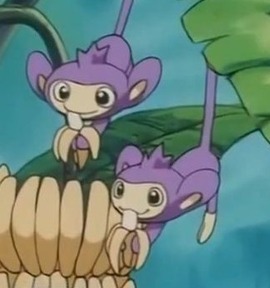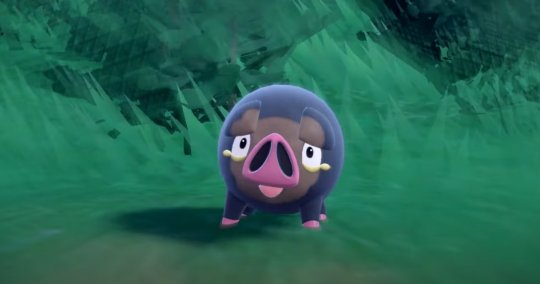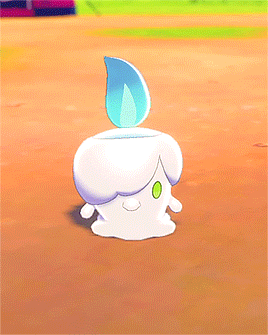Text

Pokémon Biology turned 5 today!
#tumblr birthday#tumblr milestone#what a great reminder to post more#i miss you all!#pokebiologist#pokemon biology
51 notes
·
View notes
Note
How do I provide enrichment for a Tinkaton? I don't want to be fined because it kept whacking rocks at flying bird Pokemon.
Tinkaton are very precocious creatures with strong personalities, so their enrichment often has to be varied and personalized. Dummy targets and rage room setups are very popular, but many Tinkaton will enjoy other things such as scent enrichment, or puzzle feeders that require hand-eye coordination, strength, and/or high dexterity to open. Cracking open geodes seems to be a general favorite. They also enjoy treats that they can gnaw on for long periods of time: extra tough jerky, hard rubber chew toys, and rock candies are all great. Even taking your Pokémon on long hikes when you pass the time is a great way to get them moving, looking at new things, and used to carrying their hammer around.
-Thea
156 notes
·
View notes
Text
Tinkaton are largely solitary creatures, but they will occasionally have peaceful meetings with other conspecifics wherein they trade in scraps of metal or jewels to embellish their hammers. Researchers were stumped for decades on how individuals who were known to have spent their whole lives in a single area would add stones from faraway caves to their collections, until one Ranger happened to witness and film such an exchange. The trade value that Tinkaton place on different gems and minerals remains unclear. Thus far, it seems that some individuals prefer harder, spikier pieces that will help deal more damage when they swing their hammer at foes, whereas others prefer more sparkly or colorful gems for an aesthetic effect.
-Thea
#pokemon#tinkaton#pokemon scarlet and violet#pokemon headcanons#pokemon biology#paldea#fairy type#favorite
428 notes
·
View notes
Note
How some ghost pokemon are able to drain life force? And what is meant by life force in a scientific sense?
The concept of "life force" is quite old, predating a lot of modern science, and now serves as a catchall term that remains quite handy for vernacular use.
It is not a singular thing, and therefore Ghost Pokémon may use a variety of techniques and mechanisms to "drain" it. It tends to be a chemical differential that is established with the target that leaches either heat or oxygen from bodily tissues (including lung and brain tissues). The sudden lack of these can easily cause an individual to go into shock or lose consciousness, and if prolonged can be fatal. The general ability is very useful as both a predator deterrent and as a hunting mechanism, and has therefore developed convergently in many different taxa. Victims can typically sense and later recall the process of heat and/or oxygen being pulled from their bodies, and it is apparently a similar experience across perpetrators, which is why it is regarded popularly as a draining of a singular "life force."
-Thea
98 notes
·
View notes
Note
what are the civic duties of a gym leader
They can vary pretty wildly between regions. In some places, a Gym Leader has very few legal duties beyond their literal job of taking on challengers and awarding Badges. Some Leaders will even stretch this duty somewhat thin and only take on the bare minimum of trainers in order to prioritize their own training or travel, or even another job. After all, being a Gym Leader is very prestigious but not always very lucrative.
In other places, a Gym Leader position is a more involved community leadership role, where they must be present in local council meetings and various other political decisions. It is also relatively common for Gym Leaders to have official responsibilities regarding the promotion and welfare of their specialized Type. For instance, a promotion to leadership of a Gym may also be an automatic joint appointment to head chair of a management board.
Informally, Gym Leaders bear a considerable amount of social responsibility, if only with respect to their popular influence. The Pokémon they train, the companies whose products they use, etc. tend to be in high demand among fans and trainers alike.
-Thea
153 notes
·
View notes
Text
Skeledirge incubate their Eggs in a superheated mound of smoldering vegetation. The fire deters potential predators from poaching the Eggs. Both parents will spend many weeks finding the correct materials and constructing the nest such that it can maintain a low flame for days on end. After the Eggs are laid, parents will take turns bringing new kindling and breathing new flame periodically. The qualities of the fire, temperature primary among them, are what determines the gender of the young Fuecoco.
-Thea
120 notes
·
View notes
Note
Based on the nature of Bond-Based (High Friendship/Happines) Evolution phenomena found to occur in Pokemon such as Sylveon, Pichu -> Pikachun, Snom -> Frosmoth, etc, Do you think this is as a result of the specific human - pokemon Bond or is this something that is reproducable in the wild as a Mated Pair form a bond or something similar? Any theories that you have to suggest a biological explanation? (OOC: i love your blog and it's whole idea, dunno if its been asked before but it was on my mind. Hope you're well!)
Yes! (Thank you very much!)
Those types of evolutions can be relatively diverse in biological function, but they tend to occur in species that live in either naturally high-stress or resource-poor environments that promote small body size. Formation of interpersonal (inter-Pokémon-al?) bonds establishes a few things: cooperation securing resources that may yield more than the sum of the individuals working alone; additional coverage when scouting for danger and the associated ability to range further afield; a heightened threat of competition over space/potential mates/newfound resources. All those things are easier to deal with if you have a larger and/or stronger body. Therefore, some of those species' evolutionary processes are only triggered by a hormone cascade associated with prolonged contact with other trusted individuals.
For example, Snom live in areas that are relatively extreme. Resources in arctic areas may be few and far between, and a large body with a high surface area to volume ratio (i.e. having appendages such as wings and antennae that are vulnerable to damage and energetically expensive to keep functional) can be dangerous. Groups of Snom tend to yield one or two dominant Frosmoth, that can defend territory and the group, and in turn receive food.
Meanwhile, many baby Pokémon such as Pichu and Togepi are not as precocial as other basic evolutionary forms, and require extra care and sometimes even education before they can safely set off on their own. A delayed evolution that relies on attention from family members is a good way to make sure that offspring don't leave the nest prematurely. That would essentially be a waste of parental investment, in cold-hearted biological terms.
-Thea
#ask#pokemon#pokemon headcanons#pokemon biology#evolution#evolutionary biology#ooc: i love ur pfp im a really big fan of witch hat atelier#the worldbuilding and fantasy natural history is amazing
79 notes
·
View notes
Note
Are there pokémon that predate on prey that have type advantage, like a dragon type that predates on fairy type or any thing like that?
Awesome question! Yes, that does happen somewhat frequently, and often the type advantage of the prey species was developed as a defense against predation; a classic evolutionary arms race scenario.
This is most often seen with a secondary Poison typing, where a species develops an internal toxin to ward off predators. This may be with Grass-Type species trying to deter Fairy-Type predators, or Water-Type Pokémon with Grass-Type predators.
Another pretty interesting example is Mareep. Some evolutionary biologists believe that their Electric typing was solidified in their genome after proving an effective way to reduce predation on young by Flying-Type Pokémon such as Noctowl and Fearow.
-Thea
89 notes
·
View notes
Text
Arboliva are powerful ecosystem engineers, whose slow migrations between their preferred habitat areas drive conditions that attract many other species. Their shed leaves provide nesting material to avian Pokémon, and even alter the pH of the soil when they decompose to promote the growth and health of their offspring. As such, current agricultural hotspots in Paldea are situated in throughout Arboliva troops' historical migration route. Many researchers are interested in tracking how far afield Smoliv may travel in order to establish new fertile farming areas, but Pokémon that small are very difficult to track in the long term. Maybe one day we'll have GPS devices small enough!
-Thea
100 notes
·
View notes
Text
Skeledirge have over a dozen documented distinct vocalizations, not including the screeches and roars that they use exclusively in battle. These range significantly in pitch, volume, and duration, and are used for a large variety of social communications. A favorite that has gone viral in many social media videos is the high pitched series of chirps that they use to call to and guide their young around. Many calls are outside the range of what the human ear can pick up, but some hikers have reported being able to feel the vibrations of their low rumbling growls that they use for long-distance communication- typically to warn potential competitors away from their territory. If you are hiking in known Skeledirge country and suddenly feel a slight tremor in the ground beneath your feet, it is recommended to begin a slow but deliberate retreat.
-Thea
#pokemon#pokemon headcanons#pokemon biology#pokemon scarlet and violet#pokemon paldea#skeledirge#fuecoco#favorite
279 notes
·
View notes
Text
Depending on the environmental factors of the place where a Litwick is raised, the wax they aerosolize in burning their flames may take on varying scents. Being near a Litwick that was raised in your hometown can elicit nostalgia, evoke childhood memories, or even trigger vivid flashbacks.
Certain breeders in Unova have found ways to tailor their farms to produce Litwick with specific scents so that they can give their future homes a custom aroma. This trait has helped propel Litwick to rapidly become one of the most commonly owned Ghost-Type Pokémon internationally. One entrepreneurial rancher asked the Unova Gym Leaders their favorite smells, and was able to produce Litwick in association with each Leader to great popularity.
-Thea
278 notes
·
View notes
Note
Hi Thea! I tend to several steel-type Pokemon, and recently, I've had a curious Meltan appearing near my home! I've been happily feeding him some scrap metal, but got to thinking: do I need to be concerned about Meltan being near other steel-types? Do Meltan (and other Pokemon with a similar diet) only eat non-living metal? Thank you for your help, and love the blog!
Happy to hear that!
Fortunately, since Meltan are so small, they do not pose much of a threat to Steel-Type Pokémon in terms of predation. At most, they may be a nuisance not unlike a parasite. For example, they may leave small welts on larger Pokémon if they took a "bite" from them, but it is not a serious danger. There are perhaps some risks if the welt is near a joint or pools water that could cause rusting.
That being said, I cannot find any reports of them pursuing or demonstrating a preference for live prey. Scraps of "non-living" metal (including pieces shed naturally from your other Pokémon) should be more than enough to keep the little guy happy and healthy.
-Thea
73 notes
·
View notes






